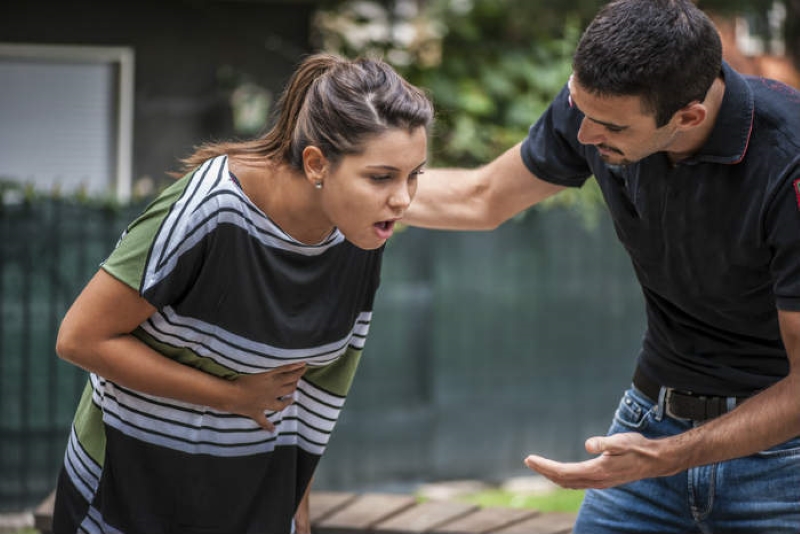
Choking with obstruction from food, liquids, saliva in children and adults: what to do?
In case of choking with airway obstruction, first of all it is advisable to recognise the symptoms of partial or total obstruction of the larynx or trachea
In partial obstruction, the foreign body obstructs the upper airway and makes the passage of air difficult, but does not prevent it completely
In this case, the subject remains alert, albeit frightened, and manages to breathe, albeit with difficulty (dyspnoea) and with a violent cough, a defence mechanism of the organism, which thus attempts to expel or at least the object, which could in some cases even be counterproductive, since the object could move to more critical positions and further occlude the airways.
Coughing may also be weak, as the victim cannot adequately fill the lungs with air.
Breathing often produces noise and the person speaks with difficulty; they also tend to bring their hands to their throat.
In the case of severe or total obstruction, on the other hand, the victim generally
- does not breathe
- does not cough;
- loses consciousness;
- becomes cyanotic (i.e. his skin turns bluish).
Saliva or various liquids do not lead to a total or severe obstruction, which can occur with an object, e.g. a toy placed in the mouth by mistake or a morsel of food that is too large and incompressible (e.g. a candy or a grape in children).
What to do in case of partial obstruction?
If the obstruction is partial and therefore the person is coughing and breathing, it is important to encourage him/her to cough, remain calm and reassure him/her.
There is no need to intervene in any way, especially if the choking is from saliva or liquids: the situation should resolve itself, however, if it is an object that causes partial obstruction, it could move and cause total obstruction, so the situation should be monitored).
What to do in case of total obstruction?
If the obstruction is from a large foreign body causing complete occlusion of the airway and therefore the victim is not breathing, prompt action must be taken.
It is important to call for help by dialling 112, but while waiting for their arrival, one must carry out the disobstruction manoeuvres.
If the manoeuvres are not known, health workers will provide telephone assistance while waiting for help to arrive.
The de-constructive manoeuvre is known as the Heimlich manoeuvre, only in children under one year old a different procedure must be implemented.
Airway obstruction, how to intervene if the subject is less than 12 months old?
If foreign bodies are visible in the front of the mouth, pull them out using a finger folded into a hook.
Only perform this operation if the material is clearly visible and easy to reach.
- sit down and place the child on its stomach on your forearm, with its head pointing outwards;
- place your arm on the corresponding leg, so as to create a plane that serves as a base;
- with an open hand, strike 5 interscapular strokes facing outwards, tapping the palm of the hand near the wrist. The blows must be firm;
- this manoeuvre may be sufficient to expel the foreign body.
If this does not happen
- turn the baby on its stomach and use your index and middle fingers to apply 5 blows to the chest, centred between the two nipples;
- alternate the 5 interscapular strokes and the 5 pressures until the passage of air is again possible.
Suffocation due to obstruction, what should be done if the subject is over 12 months old or an adult?
In this case, the Heimlich manoeuvre must be practised.
This is not a difficult procedure, but it is important to perform it precisely and carefully to avoid the risk of further damage.
- stand behind the victim, embrace him/her and bring your hands to the level of his/her stomach;
- close your hands into a fist and place one hand between your navel and chest, place the other hand on top of the first;
- push your fist down on the victim’s body in the indicated area, firmly, directing the movement deep and upwards;
- continue until breathing resumes.
Inhaling a foreign body: what NOT to do?
It is no use – and may even make the situation worse – to ‘pat’ an obstructed person on the back.
Trying to pull a foreign body out of the oral cavity with your fingers can make the situation worse because it is pushed in deeper.
Read Also
Emergency Live Even More…Live: Download The New Free App Of Your Newspaper For IOS And Android
Choking (Suffocation Or Asphyxia): Definition, Causes, Symptoms, Death
Asphyxia: Symptoms, Treatment And How Soon You Die
Emergency Interventions: The 4 Stages Preceding Death By Drowning
Drowning Resuscitation For Surfers
ERC 2018 – Nefeli Saves Lives In Greece
First Aid In Drowning Children, New Intervention Modality Suggestion
Water Rescue Dogs: How Are They Trained?
Drowning Prevention And Water Rescue: The Rip Current
Water Rescue: Drowning First Aid, Diving Injuries
RLSS UK Deploys Innovative Technologies And The Use Of Drones To Support Water Rescues / VIDEO
Summer And High Temperatures: Dehydration In Paramedics And First Responders
First Aid: Initial And Hospital Treatment Of Drowning Victims
First Aid For Dehydration: Knowing How To Respond To A Situation Not Necessarily Related To The Heat
Children At Risk Of Heat-Related Illnesses In Hot Weather: Here’s What To Do
Summer Heat And Thrombosis: Risks And Prevention
Dry And Secondary Drowning: Meaning, Symptoms And Prevention
Drowning In Salt Water Or Swimming Pool: Treatment And First Aid
Water Rescue: Drone Saves 14-Year-Old Boy From Drowning In Valencia, Spain


